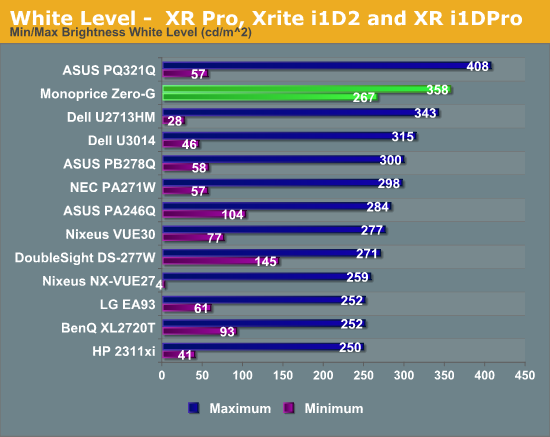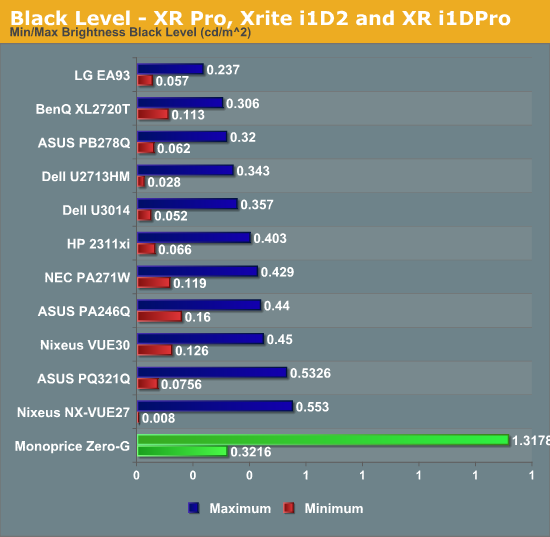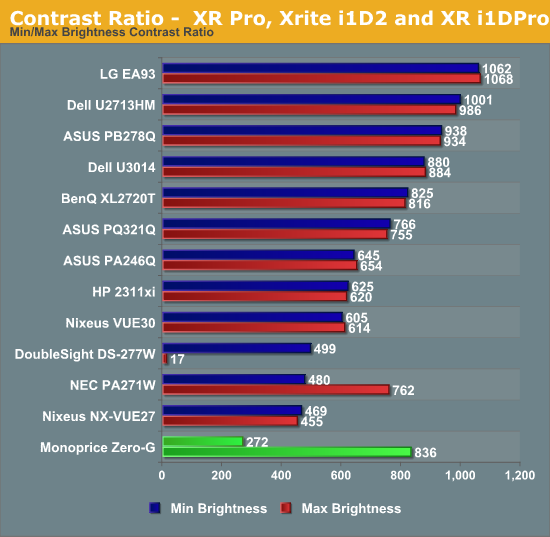Monoprice Zero-G Slim 27" IPS Monitor Review
by Chris Heinonen on August 26, 2013 12:00 AM ESTThe Zero-G is rated for 440 cd/m^2 of brightness, but with the default contrast setting I couldn’t get close to that. I only managed to produce 348 cd/m^2 of brightness with the Brightness at max and Contrast at 50. Pushing the Contrast higher might push that value higher, but it also introduces clipping that makes those settings unusable.
The curious value with the Monoprice is the minimum white level. At the default Contrast setting of 50 and the Brightness at 0, we still see 267 cd/m^2 of light output. That’s over 30% higher than our bright target for calibration and pre-calibration readings! I like to see the minimum level be closer to 80 cd/m^2 or below, so this is a small range. As you see on the chart, the Monoprice really sticks out here.

Black level also has issues. With the Brightness at 100 and Contrast at 50, we see a black level of 1.3178 cd/m^2. We really look for a value of 0.300 cd/m^2 or below to be excellent, and past 0.500 cd/m^2 is not great. Beyond 1.0 shows that we have grayish blacks, not black-blacks, and the contrast ratio is going to really suffer.
At the Brightness level of 0, our black level is a more respectable 0.3216 cd/m^2. The minimum brightness levels are what I’d expect to see at maximum brightness on a typical display. As almost everyone is using LG panels in their 27” 1440p monitors, there is something in the electronics of the Monoprice that is certainly strange.

The contrast levels, as you can imagine from that maximum brightness reading, are strange. We see a respectable contrast level of 836:1 at minimum brightness, but a maximum brightness contrast of only 272:1. When these values don’t line up with each other, or with the 200 cd/m^2 calibrated values, I go back and run this at multiple levels to see what is going on. Below is the data for the light output and contrast ratio at different brightness levels.
|
Brightness Level |
Light Output (cd/m^2) |
Contrast Ratio |
|
0 |
267 |
836:1 |
|
10 |
290 |
888:1 |
|
20 |
312 |
944:1 |
|
30 |
330 |
992:1 |
|
40 |
352 |
1054:1 |
|
50 |
354 |
1054:1 |
|
60 |
354 |
1055:1 |
|
70 |
354 |
1054:1 |
|
80 |
355 |
830:1 |
|
90 |
356 |
520:1 |
|
100 |
358 |
272:1 |
As we see the light output doesn’t really change from 40-70, and past 70 the black level rises causing the contrast ratio to fall. Contrast Ratio should be constant, with small fluctuations due to reading error. Because of the behavior seen here, I chose to do all my calibrations at the default settings of Brightness 50 and Contrast 50. However, there is something going on with the electronics inside the Monoprice display, and it doesn’t look right.
Monoprice looked into this and informed me that the backlight level is controlled by the scaler and not by the pcb mainboard. This is causing the brightness controls to not function as I expect them to, and it sounds like it won't be changed.











79 Comments
View All Comments
wetwareinterface - Thursday, August 29, 2013 - link
okay how about buying an asus vx279? retail pricing is $299. it's a good 1920x1080 ips panel and is cheaper than the monoprice monitor. sure the monoprice is higher res but for the average consumer saving $80 is more important than 2560x1440. the argument that most people looking at these and korean cheapo ips 27" are looking for something better than a tn panel doesn't hold up. these are being sold to folks who want cheaper 2560x1440 ips panels. that market is predominantly art driven not gaming driven. gamers go for 120hz or 144hz and buy multiples, those are tn panel monitors at mid $200 price points.the article is spot on in it's assesment. if you are looking at an accurate high res monitor better off getting something pre-calibrated and slightly more expensive. if you are just going for resolution for gaming better off anyway with multiple narrow bezel 1920x1080 tn panels for the performance and resolution factor.
Scannall - Monday, August 26, 2013 - link
I went the eBay route a little over a year ago and bought a Qnix. It's been a great monitor. It was $285 at the time, though they have gone up some since. If you go that route odds are that it will be fine. The gamble is on those few that aren't, and getting service.Bob Todd - Monday, August 26, 2013 - link
You act like a 5760x1080 triple setup _must_ be TN at this price point which simply isn't true. There are cheap decent quality 21.5" 1080p IPS panels for $140 or less, that are also likely calibrated better than this thing.I'm glad the prices have finally started coming down on higher res IPS panels, but if the out of the box calibration is terrible I don't think it's much of a "deal". I almost bought the Nixeus when it first came out, but I ended up with an IPS Eyefinity setup for the same price (including an awesome stand).
owan - Wednesday, August 28, 2013 - link
22" IPS panels for $140 is a very new phenomenon, so that assumption was very true until the last year or so at most.Impulses - Monday, August 26, 2013 - link
" For years now it's been cheaper to buy 3 1920x1080 21.5" tn panels than a single IPS. "That's simply not true, unless you're making some kinda illogical correlation between IPS and displays that are 27"+... I bought three 24" 1920x1200 IPS displays from Dell for $300 each about two years ago (free shipping btw). Those aren't even the cheapest IPS displays around (by far) but I paid a premium for 16:10 since it looks better in a PPP configuration.
There's plenty of IPS displays that overlap in price with the better TN displays at those sizes (<24"). Good 27"+ displays are generally IPS (and have been considerably more expensive) because A) at that size TN's viewing angles become an issue even if you sit completely still and just move your head B) displays that large are obviously more of a niche.
IPS has always been more expensive, but it's been a while since it's been prohibitively more expensive. Personally I'd still take 2-3 smaller but better displays over 1-2 displays like this one, but that's more of a personal judgment call.
Mygaffer - Monday, August 26, 2013 - link
That is pure BS. Gamers love the detail of the high resolution panel and the image quality of the IPS panel. Go to a site like Overclock.net, which has a quite large contingent of people running these and the Korean import monitors, we are talking about hundreds of people, most of whom are gaming on the monitor.Input lag is negligible on these and not so far off the TN panels you assume every gamer would want. The competitive FPS players are going to buy 120Hz panels and that leaves everyone else who can afford it with one of these inexpensive 27" IPS monitors as at least an option.
owan - Wednesday, August 28, 2013 - link
I definitely disagree. I own a Korean monitor and was a TN user... but I was a TN user by price bracket rather than choice (even though I'm a gamer). To say "oh the extra $200 is worth it" completely ignores the fact that (probably) most people who are seriously looking at one of these in the first place are already really reaching to get one of these. For another $200 to get to a sale-priced Dell, those same people are now going to be paying 3-4X what they paid for their current monitorBigHugeNerd - Saturday, August 31, 2013 - link
Actually, you can. Check out the Eizo FS2333. I bought one for gaming. And it's better than any TN panel I've used in every way.Rolfathan - Tuesday, October 1, 2013 - link
I actually already got a Asus IPS monitor that has better color settings for my art. It has more even backlighting, as well as a better backlight, and while the differences between my Auira 2560x1440 IPS (got it for $350 at Microcenter, open box) are slim, the shades of red do seem better on the Asus IPS.My point is, I survived on FPS games at 14ms refresh times in 2004. I see no reason why I couldn't today, so I game at 2560x1440.
The games looking amazing, and since a cut down on the anti-aliasing (you don't need AA as much at this resolution, so when you played AA8 you can now cut it down to AA2 and it still looks better than AA8 did on a 1920x1080 monitor)
Now this compromise actually makes my games lag less. So I'm actually getting a more consistent experience this way. Not that lag was a constant issue, but it was very annoying when it did happen. So all in all, this kind of monitor has greatly improved my gaming.
Add to that being able to physically see "more" of what is going on around you, there's a chance you have an upper-hand in being able to see another player slightly before they notice you.
jaydee - Monday, August 26, 2013 - link
I agree it's a bit odd, the author would compare the retail price ($400) of the Monoprice 27" IPS against the sale price ($385) of the Nixieus. Compare retail price ($485 Nixeus) against retail price ($390 Monoprice), or sale price ($385 Nixeus) against sale price ($312 Monoprice).Side note, I'd like to see a review of the AOC Q2963M, 29" 2560x1080 IPS, which "sale price" is $370-400 ($400 at the moment), retail is ~$500.